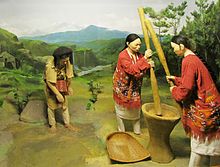Sherdukpen people

Diorama of the Sherdukpen people at the Jawaharlal Nehru Museum, Itanagar, Arunachal Pradesh
|
|
| Total population | |
|---|---|
| 4,200 | |
| Regions with significant populations | |
|
Arunachal Pradesh |
4,200 |
| Languages | |
| Sherdukpen language, Tshangla, Assamese | |
| Religion | |
| Tibetan Buddhism, Animism | |
| Related ethnic groups | |
| Monpa, Aka, Khowa | |
The Sherdukpen are an ethnic group related to both the Aka and Monpa. Their population of 4,200 is centered in West Kameng in the villages of Rupa, Jigaon, Thongri, Shergaon, in Bomdila. All of these are at elevations between 5000–6000 feet above sea level. Of late, some of them have settled in Kameng bari areas, a new settlement area under Bhalukpong circle.
Sherdukpen society is divided into two classes: The Thong and Chao, the former of which–the higher caste–are divided into eight clans. Marriage between castes are considered taboo within the tribal society and are strongly discouraged. Local legend mentioned that the upper caste are the descendants of a Tibetan king (a grandson of Songtsän Gampo) and Ahom princess, of which they bore two sons. The Chao are the descendants of the king's porters and servants. The Sherdukpens migrate to Doimara (a lowland hamlet close to the Assamese border) and stayed between December to March on an annual basis during the winter months, a tradition with which the tribe maintain the memory of their Assamese ancestry. In Doimara, the Sherdukpens mingled with the nearby Assamese natives and traded for rice.
The Sherdukpen generally practice monogamy and trace their descent patrilineally. Their houses are built on strong stone foundations with their wall and floor made from thick wooden planks.
The Sherdukpen are agriculturalists, although hunting and traditional fishing methods are practised as well. Using simple tools, both shifting and permanent farming methods are used, and livestock such as ponies, cows, goats, sheep, fowls and bullocks are kept.
The Sherdukpen speak their own language, Sherdukpen, which isn't directly related with the neighboring Bugun/Aka/Monpa language. It is possibly of Tibeto-Burman derivation.
...
Wikipedia
